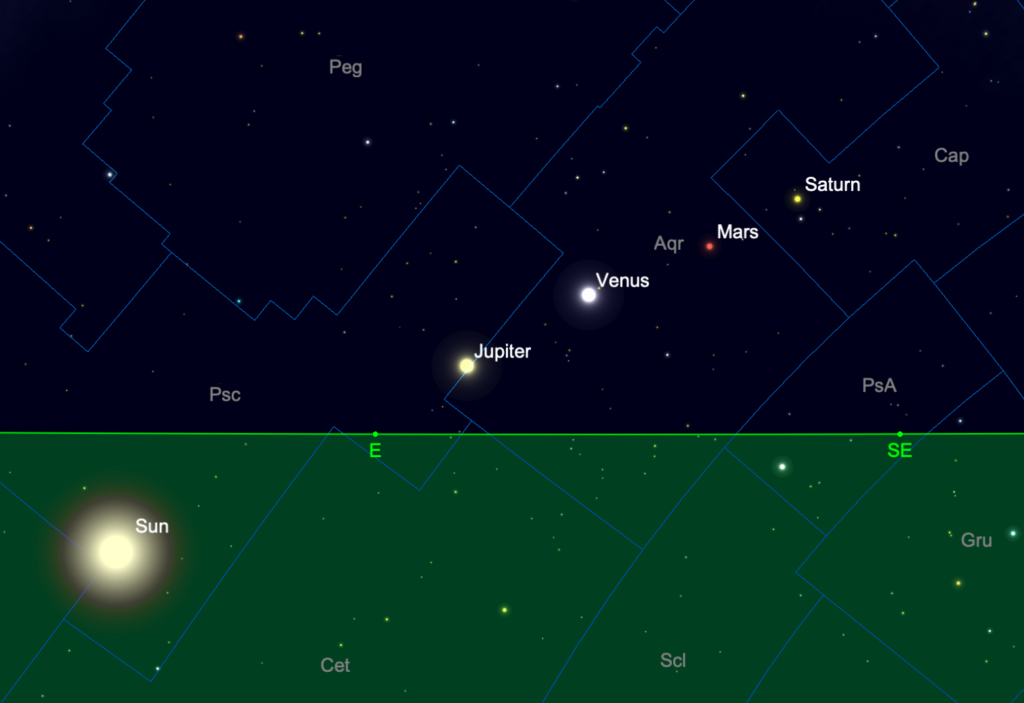Sky Report: April 11-17

The planets are nearly equally spaced in a line 45 minutes before sunrise on Sunday morning, April 17. Venus and Jupiter are 12° apart – slightly more than the width of your fist held at arm’s length. The horizon is translucent so you can see the sun too. Constellation boundaries are blue lines and the constellation names are abbreviated.
The parade of planets continues in the morning sky and is well-worth making the effort to see. There are a few highlights in the weeks ahead, but again, as I continue to belabor, the planets’ motions are a continuous series of day-by-day (or morning-by-morning) motions but not isolated, discreet events. When the planets appear close together, as they do now, you can see their motions relative to each other in a continuously changing tableau. Soon they will have spread out and the opportunity will have passed.
That said, key mornings are April 27 and April 30, but plenty is happening between now and then.
On the morning of the 17th the four planets (from L to R, or E to W) are Jupiter, Venus, Mars, and Saturn – and remarkably, they’re almost perfectly evenly spaced with about 10° between them! This is a rather rare curiosity. Look about 45 min before sunrise because Jupiter is just now returning from its passage behind the sun and it’s very, very low – only a few degrees above the eastern horizon. Few people will see it because you’ll need a flat horizon uninterrupted by vegetation, houses, or hills, plus clear air, but Jupiter is so bright that you might spot it, especially with binoculars. Jupiter rises earlier each day and becomes progressively easier to see, but this week is your first chance to see it – so if your horizon permits it, go for it.
Venus is the brilliant “Morning Star” and it’s high enough for most people to easily see it. Venus rises later each morning and is progressively lower at the same time, so enjoy it before we lose it in only a handful of weeks.
Mars and Saturn are much fainter (only 1/100th as bright as Venus), but they’re higher and you should have no trouble seeing them, especially with binoculars. The four planets mark the ecliptic, the plane of the solar system seen edge-on.
This equal-spacing does not last, as each planet is in motion. Venus is moving toward Jupiter and if you can see both try to estimate when Venus will reach Jupiter in what will be perhaps the nicest conjunction of 2022 – for those who can see it.
This is only a curiosity because you’re not likely to actually see it, but Neptune is especially close to Jupiter for several days surrounding the 12th, when they’re an incredible 1/10° apart. That almost puts Neptune among Jupiter’s moons (Neptune will appear closer to Jupiter than Jupiter’s moon Callisto that morning.) Jupiter is bright enough to see when it’s near the horizon but Neptune is 1/13,000th as bright, so it’s far too faint to actually see it when it’s so low.
This year Easter falls on April 17, and that’s a date that is determined astronomically. Simply put, Easter is set to fall on the first Sunday after the first full moon (April 16) after the March equinox (March 20), although it’s a bit more complicated; Uncle Google can give you the details (I recommend “The Old Farmer’s Almanac”.)
Thanks to a 2021 grant from the Utah Governor’s Office of Economic Opportunity and the Kane County Office of Tourism, Stellar Vista Observatory offers portable telescopes and tripod mounted binocular kits on loan for free to all residents of Kane County. Nothing beats a quality binocular or astronomical telescope to enhance enjoyment of the night sky!
Visit https://stellarvistaobservatory.org/discover-the-night-sky/ or Kanab City Library for full details.
The Sky Report is presented as a public service by the Stellar Vista Observatory, a nonprofit organization based in Kanab, Utah, which provides opportunities for people to observe, appreciate, and comprehend our starry night sky. Additional information is at www.stellarvistaobservatory.org. Send questions and comments to John@StargazingAdventures.org.






Comments are closed.